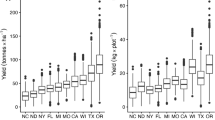Abstract
Introduction of the Andean grain chenopod (Chenopodium quinoa) into North America placed this crop within the distributional range of a related wild species,C. berlandieri. This wild species, native to the North American flora, is cross-compatible withC. Quinoa. Isozyme analysis of progeny fromC. berlandieri plants growing within and at the periphery of theC. Quinoa fields, combined with fertility assessment and phenetic comparison among putative hybrids and parental types, indicates that over 30% of progeny from wild plants growing as weeds withC. quinoa in 1987 were crop/weed hybrids. This high incidence of interspecific gene flow from crop to weed appears to be the result of asymmetric pollen flow to free-living plants from high-density cultivated populations. The observed level of crop/weed hybridization, combined with heterosis and partial fertility of F1 crop/weed hybrids, suggests that repeated annual cycles ofC. quinoa cultivation within the North American range ofC. berlandieri could produce introgressive change among sympatric wild populations. In terms of risk assessment for biotechnology, these results suggest that the breeding system may not provide an accurate indication of the potential for genetic interaction among predominately self-pollinating grain crops and their free-living relatives.
Similar content being viewed by others
References
Doebley J (1992) Molecular systematics and crop evolution. In: Soltis PS, Soltis DE, Doyle JJ (eds) Molecular systematics of plants. Chapman and Hall, New York, pp 202–222
Ellstrand NC, Devlin B, Marshall DL (1989) Gene flow by pollen into small populations: data from experimental and natural stands of wild radish. Proc Natl Acad Sci USA 86:9044–9047
Ellstrand NC, Hoffman CA (1990) Hybridization as an avenue of escape for engineered genes. Bioscience 40:438–442
Harlan JR (1975) Crops and man. American Society of Agronomy, Crop Science Society of Agronomy, Madison, Wisconsin, USA
Langevin SA, Clay K, Grace JB (1990) The incidence and effects of hybridization between cultivated rice and its related weed red rice (Oryza sativa L.). Evolution 44:1000–1008
Small E (1984) Hybridization in the domesticated-weed-wild complex. In: Grant WF (ed) Plant biosystematics. Academic Press, Toronto, pp 193–210
Till-Bottraud I, Reboud X, Brabant P, Lefranc M, Rherissi B, Vedel F, Marmency H (1992) Outcrossing and hybridization in wild and cultivated foxtail millets: consequences for the release of transgenic crops. Theor Appl Genet 83:940–946
U.S. National Research Council (1989) Field testing genetically modified organisms: framework for decisions. National Academy Press, Washington, D.C.
Walters T (1987) Electrophoretic evidence for the evolutionary relationship of the tetraploidChenopodium berlandieri to its putative diploid progenitors. Selbyana 10:36–55
Wilson HD (1980) Artificial hybridization among species ofChenopodium sectionChenopodium. Systematic Bot 5:253–263
Wilson HD (1991a) Genetic variation among South American populations of tretraploidChenopodium sect.Chenopodium subsect.Cellulata. Systematic Bot 6:380–398
Wilson HD (1991b) DomesticatedChenopodium of the Ozark Bluff Dwellers. Econ Bot 35:233–239
Wilson HD (1985)Chenopodium quinoa Willd.: variation and relationships in southern South America. Nat Geog Soc Res Repts 19:711–721
Wilson HD (1988a) Allozyme variation and phenetic relationships ofChenopodium hircinum Schrader (s. lat). Systematic Bot 13:215–228
Wilson HD (1988b) Quinua biosystematics. I. domesticated populations. Econ bot 42:461–477
Wilson HD (1988c) Quinua biosystematics. II. free-living populations. Econ Bot 42:478–494
Wilson HD (1990a) Quinua and relatives (Chenopodium sect.Chenopodium subsect.).Cellulata. Econ Bot 44:92–110
Wilson HD (1990b) Gene flow in squash species. Bioscience 40:449–455
Wilson HD, Heiser CB Jr. (1979) The origin and evolutionary relationships of ‘Huauzontle’ (Chenopodium nuttalliae Safford), domesticated chenopod of Mexico. Am J Bot 66:198–206
Wood RW (1988) Quinoa — The supergrain. Japan Publications, Tokyo
Author information
Authors and Affiliations
Additional information
Communicated by I. Mac Key
Rights and permissions
About this article
Cite this article
Wilson, H., Manhart, J. Crop/weed gene flow:Chenopodium quinoa Willd. andC. berlandieri Moq.. Theoret. Appl. Genetics 86, 642–648 (1993). https://doi.org/10.1007/BF00838721
Received:
Accepted:
Issue Date:
DOI: https://doi.org/10.1007/BF00838721




